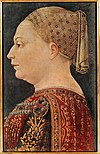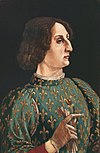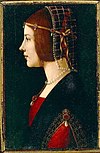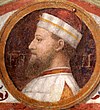Sforza
Sforza ( Italian for "conqueror") is the name of one of the great Italian families of the Renaissance . From 1450 to 1535 they ruled (with interruptions) as dukes of Milan in Lombardy .
Family history
origin
The Sforza family was actually called Attendolo, belonged to the peasant nobility of the province of Ravenna and owned considerable land in the municipality of Cotignola , which is about 20 km west of the city of Ravenna . The town and the Attendolo family were subordinate to the respective feudal lords - for a long time the Counts of Cunio - who later called themselves "da Barbiano" after the rule of Barbiano (today part of the municipality of Cotignola). This family of the Italian nobility was already mentioned by Dante in his " Divine Comedy ", brought a number of famous condottieri such as u. a. Alberico da Barbiano (* 1348, † 1409) emerged, one line was raised to the imperial prince status, another flourishes in the count line to this day.
The family name Sforza goes back to Jacopo Attendolo, called Giacomuzzo Attendolo (born May 28, 1369 in Cotignola, † January 4, 1424, drowned in the Pescara River), who was one of the most famous condottieri of his time. Because of his Herculean strength he was called "Sforza" and as such he was famous. This moniker was adopted as a family name by his descendants. Muzio Attendolo Sforza managed to acquire the Cotignola rule in 1411, which was elevated to a county in his favor, making him the first Count of Cotignola. He was married three times and had at least 15 children, in addition to legitimate children, as well as a large number of illegitimate children who were later legitimized.
Francesco Sforza

His illegitimate son Francesco Sforza (* 1401, † 1466) took command, showed military genius and political acumen. He served the Visconti against Venice and then Venice against the Visconti, attacked the Pope, drove him out of Romagna, and later defended him. In 1441 he married Bianca Maria, the only daughter of Filippo Maria Visconti , Duke of Milan , received Pontremoli and Cremona as a dowry, as well as the promise of successor in the duchy. The short-lived Ambrosian Republic , established by the Milanese when Visconti died (1447), was subjugated by Francesco, who triumphantly entered the city as Duke on March 25, 1450. In the Peace of Lodi in 1454 he achieved recognition of his rule by the other Italian states (for example Venice) and France . He suppressed an uprising in Piacenza , allied closely with Cosimo de 'Medici (1389–1464) and Louis XI. of France (ruled 1461–1483), and ruled Lombardy , some areas south of the Po and even Genoa . He had the Porta Giovio fortress rebuilt, the great hospital and the Martesana Canal, which connects Milan with the Adda ; his court, which he filled with Italian scholars and Greek exiles, quickly became one of the most distinguished in Italy. His daughter Ippolita was famous for her Latin speeches. Francesco left several sons, including Galeazzo Maria, Ludovico, called il Moro "the dark one" or "the Moor", and Ascanio Sforza , who became a cardinal .
Galeazzo Maria Sforza and his descendants
Galeazzo Maria Sforza , who followed in the duchy, was born in 1444, was an art lover, an accomplished speaker, but cruel. He was murdered in the Cathedral of Milan on December 26, 1476 by three young Milanese nobles.
His legitimate daughter Bianca Maria Sforza (1472–1510 / 11) married the German king and later Emperor Maximilian I in 1493 , his illegitimate daughter was Caterina Sforza , Countess of Forlí.
Gian Galeazzo Sforza (* 1469; † 1494), son of Galeazzo Maria, succeeded him as duke under the reign of his mother, Bona of Savoy, who was ousted in 1481 by her son's uncle, Ludovico il Moro. Gian Galeazzo married Isabella of Aragon, granddaughter of the King of Naples, his sudden death was attributed to a poison attack by his uncle.
His daughter Bona Sforza (* 1491; † 1557) married King Sigismund I of Poland in 1518 (ruled 1506–1548). She showed remarkable qualities as regent, built castles, schools and hospitals, but also generated corruption and intrigue at the Polish court. She was charged with poisoning her daughter-in-law, the wife of Sigismund II August (ruled 1548–1572). After the death of her husband, she returned to Italy and was poisoned there by her lover Pappacoda in 1557.
Ludovico Sforza
Francesco Sforza's fifth son Ludovico Sforza , il Moro (* 1452; † 1508) was the famous patron of Leonardo da Vinci and other artists who brought Charles VIII of France (ruled 1483–1498) to help in 1494, and the ducal crown from the Milanese nobility received on October 22 of the same year. However, when he saw his own position in danger from French politics, he joined the alliance against Charles VIII, married his niece Bianca Maria Sforza to the German king and later Emperor Maximilian I, and in return received the Investiture in Milan. Ludovico was by Louis XII. (ruled 1498–1515) expelled from Milan in 1499, reinstated for a short time by the Swiss , but then delivered by them to the French in April 1500. He died as a prisoner in Loches Castle . Francesco Sforza, the son of Gian Galeazzo, was also from Louis XII. brought to France, where he became Abbot of Marmoutier in 1505 and died in 1511.
Ludovico's two sons, Massimiliano and Francesco Maria , fled to Germany; The former was reinstated by the Swiss in Milan in 1512, but after the crushing defeat of his allies in the Battle of Marignano in 1515, he ceded his rights to Francis I (ruled 1515–1547) in return for a pension of 30,000 ducats and died in Paris in 1530 . The second son, Francesco Maria, took possession of Milan after the French defeat at La Bicocca in 1522, and later joined the Italian league against Emperor Charles V (ruled 1519–1555). He was unpopular due to his tax collections, and his death on October 24, 1535 marked the end of the Sforza's direct male line. The duchy passed to the emperor.
Family relationships
- 1st line of the first generations
Muzio Attendolo, a wealthy landowner in the municipality of Cotignola (in the province of Ravenna ), traceable in 1350
- Nascimbene Attendolo
- Lorenzo Attendolo (* around 1351; † 1442) condottiere in the service of the Kingdom of Naples and the Pope, 1415 viceroy of Otranto and Taranto , vicar (governor) in Torgemella, Todi and Gualdo, was appointed in 1417 by Joan II , Queen of Naples (1414 –1435), and also raised to the rank of count by Pope Martin V (Oddo Colonna) , viceroy of the Principate in 1417, of Molise and the Terra di Lavoro. 1419 Lord of Cassano, 1420 Lord of Corato, Bisceglie , Ruvo and Terlizzi
- Giovanni Battista, fate unknown
- Lorenzo Attendolo (* around 1351; † 1442) condottiere in the service of the Kingdom of Naples and the Pope, 1415 viceroy of Otranto and Taranto , vicar (governor) in Torgemella, Todi and Gualdo, was appointed in 1417 by Joan II , Queen of Naples (1414 –1435), and also raised to the rank of count by Pope Martin V (Oddo Colonna) , viceroy of the Principate in 1417, of Molise and the Terra di Lavoro. 1419 Lord of Cassano, 1420 Lord of Corato, Bisceglie , Ruvo and Terlizzi
- Giovanni Attendolo, large landowner in Cotignola, († after 1385/86), ⚭ Elisa Petraccini, daughter of Ugolino Petraccini
- Bosio Attendolo († from malaria in May 1411 in Spoleto ), condottiere in the service of his brother Muzio, as well as in that of Ladislaus , King of Naples (1386-1414), the Marquis of Ferrara from the House of Este and the Republic of Florence , marries one by name unknown lady
- Domenico Attendolo (* around 1360; † after 1437), Lord of Acquaviva , Mola, Rutigliano, San Nicandro Garganico and Cellamare (in the province of Bari in Apulia), ⚭ Giovannella Gesualdo (* around 1391; † around 1440), Signora di Gioia del Colle (Province of Bari), daughter of Sansone I. Gesualdo, Signore di Frigento , (descendants in the female line)
- Margherita Attendolo, Signora di Muzio, first married Michele de 'Ravignani, patrician of Naples, and her second marriage was Giacomo Gaetani, Conte di Morcone
- Muzio Attendolo Sforza , actually Jacopo Attendolo, called Giacomuzio, later called "Sforza" (* May 28, 1369 in Cotignola; † January 4, 1424, drowned in the Pescara River), famous condotters, descendants: see below
- Francesco Attendolo, called "Becaletto" († 1412 at the plague in Marciano, was buried there in the Attendolo chapel), condottiers in the service of his brother, in the service of Perugia , Florence and Siena
- Bertoldo Attendolo, called "Capitan Fedele" (The Faithful Captain), (* before 1388; † June 1412 at the plague, near Perugia , was buried in the chapel of the Attendolo in Marciano), condottiere in the service of his brother Muzio Sforza
- Giorgio Attendolo
- Matteo Attendolo was killed in a feud with the Pasolini family in Cotignola in the winter of 1388
- Tonduzzo Attendolo, like his brother Matteo, was killed in a feud with the Pasolini family in Cotignola in the winter of 1388
- Maria Attendolo († 1412), ⚭ 1395 Marchese Niccolò Pallavicino
- Bosio Attendolo († from malaria in May 1411 in Spoleto ), condottiere in the service of his brother Muzio, as well as in that of Ladislaus , King of Naples (1386-1414), the Marquis of Ferrara from the House of Este and the Republic of Florence , marries one by name unknown lady
- Sante Attendolo
- Bartolo Attendolo
- Michele Attendolo, called "Michelotto" (* around 1370; † around 1451 in Palazzolo sull'Oglio?), Famous condottier in the service of the King of Naples , the Church, the Estonians, the Republic of Florence and Venice, Signore di Acquapendente , Potenza , Alianello and Castelfranco Veneto, married on March 11, 1422 Polissena (Antonella) Sanseverino († October 15, 1427/1430), mistress of San Marco and Monttafollone, widow of Andrea Malatesta , master of Cesena etc., a daughter of Venzeslao Sanseverino , Duke of Amalfi and Margherita di Sangineto - all children out of wedlock, no permanent descendants
- Raimondo Attendolo, married to Giulia Maruccia
- Pietro, called Perino Attendolo († in November 1421), condotters in the service of the House of Anjou-Valois , was raised to Count of Troia (in the province of Foggia in Apulia ) in December 1411 , and was viceroy in Rome for the House of Anjou-Valois in 1414 , married to Elena Pico
- Pietrantonio Attendolo, married to Lucrezia Fregoso (* 1433; † 1487) Signora di Gropparello, daughter of the Spinetta Fregoso Doge of the Republic of Genoa and Antonia Malaspina
- Francesca Attendolo, married to Marchetto Attendolo (see below)
- Michele Attendolo, called "Michelotto" (* around 1370; † around 1451 in Palazzolo sull'Oglio?), Famous condottier in the service of the King of Naples , the Church, the Estonians, the Republic of Florence and Venice, Signore di Acquapendente , Potenza , Alianello and Castelfranco Veneto, married on March 11, 1422 Polissena (Antonella) Sanseverino († October 15, 1427/1430), mistress of San Marco and Monttafollone, widow of Andrea Malatesta , master of Cesena etc., a daughter of Venzeslao Sanseverino , Duke of Amalfi and Margherita di Sangineto - all children out of wedlock, no permanent descendants
-
NN , a son with an unknown first name
- Marchetto Attendolo († 1466 in Piacenza ), Lord of Lucera and San Severo (both in the province of Foggia in southern Italy ), ⚭ Francesca Attendolo, an illegitimate daughter of Michele Attendolo (see above), no children
- Foschino Attendolo (June 1392; † 1457 in Milan ), Lord of Torremaggiore (in the province of Foggia in Apulia ), 1427 general captain of the "Principato Ultra" (subdivision of the earlier Principate of Benevento in the Kingdom of Naples ), of Montorio and of Capitanata ( Region in Apulia), was rector of Benevento in August 1437, castellan (castle captain) of Milan in 1442, governor of Cremona in 1444 , ducal governor of Novara and Brianza in 1449 , ducal governor of Lodi in 1450, castellan of Milan in 1452. no children
- 2. Descendants of Muzio Attendolo Sforza in extracts
Muzio Attendolo Sforza (* 1369, † 1424) was married three times. However, the following sons come from the relationship with his lover Lucia Terziani:
-
Francesco I. Sforza (* 1401; † 1466), Duke of Milan (1450–1466) ⚭ Bianca Maria Visconti, illegitimate daughter of Filippo Maria Visconti (* 1392; † 1447), Duke of Milan (1412–1447)
-
Galeazzo Maria Sforza (1444–1476), Duke of Milan (1466–1476)
- Caterina Sforza (* 1463; † 1509), out of wedlock
-
Gian Galeazzo Sforza (* 1469; † 1494), married, Duke of Milan (1476–1494)
- Francesco, called "il Ducchetto" (* 1491; † 1511), Count of Pavia (1491–1494), from 1500 abbot of Marmoutier
- Bona Sforza (* 1494; † 1557), ⚭ 1518 Sigismund I (* 1467; † 1548), King of Poland (1506–1548)
- Bianca Maria Sforza (* 1472; † 1510), ⚭ 1494 Maximilian I Archduke of Austria , 1486 Roman-German King , Emperor (1508–1519)
- Anna Maria Sforza (* 1473; † 1497), ⚭ 1491 Alfonso I d'Este (* 1476; † 1534), Duke of Ferrara etc. (1505-1535)
- Ippolita Sforza, ⚭ 1465 Alfonso II of Aragon (* 1448; † 1495), King of Naples (1494–1495)
- Filippo Maria Sforza (* 1448; † 1492), ⚭ Konstanze Sforza, daughter of Bosio Sforza
- Sforza Maria Sforza (* 1449; † 1479 poisoned), from 1464 Duke of Bari etc.
-
Ludovico I. Maria Sforza , called "il Moro" (* 1451; † 1508), Duke of Milan (1494–1499), deposed, dies in French captivity
- Ercole Massimiliano I. Sforza (* 1493; † 1530), Duke of Milan (1512–1515), deposed, dies in French captivity
- Sforza Francesco II. Sforza (* 1495; † 1535), Duke of Milan (1521–1524) deposed, (1525–1529) after his death the duchy falls to Emperor Charles V.
- Giovanni Paolo I. Sforza , son out of wedlock with Lucrezia Crivelli, 1st Marchese of Caravaggio (Lombardy)
- Ascanio Maria Sforza (* 1455; † 1505), cardinal since 1485, bishop of Pavia in 1479, of Cremona in 1486, of Novara in 1504
-
Galeazzo Maria Sforza (1444–1476), Duke of Milan (1466–1476)
-
Alessandro Sforza (* 1409; † 1473), Vicar and Lord of Ancona (1434–1473), of Pesaro (1445–1473), Duke of Sora
- Battista Sforza (* 1446; † 1472), ⚭ 1460 Federico da Montefeltro , Duke of Urbino (1444–1482)
- Costanzo I. Sforza (* 1447; † 1483), Signore of Pesaro (1473–1483)
- Giovanni Sforza (* 1466; † 1510), out of wedlock, Signore of Pesaro (1483–1500) and (1503–1510), ⚭ 1) 1489 Maddalena Gonzaga († 1490), daughter of Federico I Gonzaga , Margrave of Mantua, ⚭ 2) 1493, divorced in 1497, Lucrezia Borgia (* 1480, † 1519), daughter of Pope Alexander VI. (Rodrigo Borgia)
- Bosio I. Sforza (* 1411; † 1476), Count of Cotignola , his descendants are Counts of Santa Fiora etc., from 1585 dukes of Segni, from 1612 dukes of Onano and from 1697 dukes Sforza Cesarini , the last descendant of this line was Don Salvatore Sforza-Cesarini, 7th Prince di Genzano († 1832), his titles and possessions passed to his half-brother Lorenzo Filippo Montani, illegitimate son of his mother who was later legitimized by marriage to the Russian Colonel Carl Marschall, whose descendants are still alive today, the current title holder is Don Bosio Lorenzo Duca Sforza-Cesarini (* 1939 in Rome), 12th Prince di Genzano, Duca di Segni, Duca di Civitalavinia, Duca di Ginestra, Duca di Torricella
Significant namesake
| Surname | portrait | position |
|---|---|---|
| Muzio Attendolo Sforza |  |
Founder of the Sforza House |
| Francesco I. Sforza |  |
Son of Muzio Attendolo, first Duke of Milan (1450–1466) from the Sforza family, succeeding his father-in-law Filippo Maria Visconti |
| Bianca Maria Visconti |  |
Wife of Francesco I Sforza , illegitimate daughter of Filippo Maria Visconti , Duke of Milan |
| Galeazzo Maria Sforza |  |
Son of Francesco I. Sforza and Bianca Maria Visconti; Duke of Milan (1466–1476) |
| Gian Galeazzo Sforza |  |
Duke of Milan (1476–1494), son of Galeazzo Maria Sforza |
| Bona Sforza , Queen of Poland |  |
Daughter of Gian Galeazzo Sforza , wife of Sigismund I. |
| Bianca Maria Sforza , Roman-German Empress |  |
Daughter of Galeazzo Maria Sforza , wife of Emperor Maximilian I. |
| Anna Maria Sforza |  |
Daughter of Galeazzo Maria Sforza , wife of Alfonso I d'Este , Duke of Ferrara |
| Caterina Sforza |  |
Illegitimate daughter of Galeazzo Maria Sforza , according to a controversial theory the Mona Lisa of Leonardo da Vinci |
| Ludovico Sforza |  |
Son of Francesco I. Sforza and Bianca Maria Visconti ; Duke of Milan (1494–1499), deposed, died in French captivity |
| Beatrice d'Este |  |
Wife of Ludovico Sforza |
| Massimiliano Sforza |  |
1st son of Ludovico Sforza ; Duke of Milan (1512–1515), deposed, died in French captivity |
| Francesco II Sforza |  |
2. Son of Ludovico Sforza , Duke of Milan (1521–1524), deposed, after his death in 1535 the duchy falls to Emperor Charles V. |
| Giovanni Paolo I. Sforza |  |
Illegitimate son of Ludovico Sforza , 1st Marchese of Caravaggio (Lombardy) |
literature
- Sforza . In: Meyers Großes Konversations-Lexikon . 6th edition. Volume 18, Bibliographisches Institut, Leipzig / Vienna 1909, p. 396 .
- Sforza . In: Encyclopædia Britannica . 11th edition. tape 24 : Sainte-Claire Deville - Shuttle . London 1911, p. 756 (English, full text [ Wikisource ]).
- Sforza in the Enciclopedia Italiana on treccani.it (Italian)
- Lacy Collison-Morley: The Story of the Sforzas . New York 1934
Web links
- Sforza family tree (genmarenostrum.com, Italian) accessed May 17, 2013
- Family tree of the Sforza Cesarini
Individual evidence
- ^ Date Alighieri. “Divine Comedy” Purgatorio XV. Singing.
- ↑ according to the "Libro d'Oro della Nobiltà Mediterranea"


